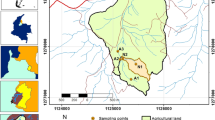Abstract
Pollutant concentrations and loads returned to the lower Murray River (South Australia) from flood-irrigated agriculture were monitored over a period of 2 years at six locations. This monitoring programme was designed to provide a baseline prior to environmental improvements being undertaken to reduce pollutant loads returned to the river. Pollutant (Escherichia coli, total nitrogen, oxidised nitrogen, total phosphorus, filtered reactive phosphorus and total organic carbon) concentrations were significantly (p < 0.01) higher in the drainage water than the river water and increased during the irrigation season. Salt concentrations were also significantly (p < 0.01) higher in the drainage water than the river inflow water but decreased during the irrigation season because of dilution of the saline groundwater inputs. Pollutant loads exported to the river were significantly higher (p < 0.01–0.05) during the irrigation season for all water quality parameters except oxidised nitrogen. Levels of oxidised nitrogen, filtered reactive phosphorus and E. coli increased in the river downstream of the where the agricultural pollutant inputs begin. Load calculations indicated that this increased water pollution is likely due to the pollutant contributions from the flood-irrigated areas and biogeochemical processing of dissolved nutrients in the river.




Similar content being viewed by others
References
APHA (2005). Standard methods for the examination of water and wastewater, 21st edition. American Public Health Association.
Aulakh, M. S., & Bijay-Singh. (1997). Nitrogen losses and fertilizer N use efficiency in irrigated porous soils. Nutrient Cycling in Agroecosystems, 47, 197–212.
Bethune, M. G., & Armstrong, D. P. (2004). Overview of the irrigated dairy industry in Australia. Australian Journal of Experimental Agriculture, 44, 127–130.
Causapé, J., Quílez, D., & Aragüés, R. (2004). Assessment of irrigation and environmental quality at the hydrological basin level II. Salt and nitrate loads in irrigation return flows. Agricultural Water Management, 70, 211–228.
DWLBC (2003). Regional salt and water balances for the Lower Murray in South Australia. Report 2003/27, Department of Water Land and Biodiversity Conservation, Adelaide, South Australia.
Fleming, N. K., Cox, J. C., Hutson, J. L., & Gepp, M. J. (2003). Reduced nutrient loads to the lower Murray in South Australia, milestone report no. 17―Final Report Year 2. South Australian Research and Development Institute, Adelaide.
Harris, G. P. (2001). A nutrient dynamics model for Australian waterways: Land use, catchment biogeochemistry and water quality in Australian Rivers, Lakes and Estuaries, Australian State of the Environment Second Technical Paper Series (Inland Waters), Department of Environment and Heritage, Canberra.
Isidoro, D., Quílez, D., & Aragüés, R. (2006). Environmental Impact of Irrigation in La Violada District (Spain): II. Nitrogen fertilization and nitrate export patterns in drainage water. Journal of Environmental Quality, 35, 776–785.
Lin, J. P. (2004). Review of published export coefficient and event mean concentration (EMC) data. WRAP Technical Notes Collection (ERDC TN-WRAP-04-3), U.S. Army Engineer Research and Development Center, Vicksburg, MS.
Mishra, A., Benham, B. L., & Mostaghimi, S. (2007). Bacterial transport from agricultural lands fertilized with animal manure. Water, Air, and Soil Pollution, 189, 127–134.
Murray, M. B., & Philcox, M. (1995). An assessment of irrigation runoff from flood irrigated dairy pastures of the Lower Murray. Primary Industries and Resources South Australia, Adelaide.
O’Kane, B. (2004). Sustainable dairy farming—Is this an oxymoron? The Australian Journal of Dairy Technology, 59, 129–131.
Pakrou, N., & Dillion, P. J. (2000). Key processes of the nitrogen cycle in an irrigated and non-irrigated grazed pasture. Plant and Soil, 224, 231–50.
Pakrou, N., & Dillion, P. J. (2004). Leaching losses of N under grazed irrigated and non-irrigated pastures. Journal of Agricultural Science, 142, 503–16.
SA EPA. (2001). Ambient water quality monitoring of the Murray River 1990−1999. Adelaide: South Australian Environment Protection Authority.
SA EPA. (2005). Cowirra surface irrigation re-use trial. Adelaide: South Australian Environment Protection Authority.
SA EPA. (2008). Lower murray reclaimed irrigation area environmental monitoring report, phase 1. Adelaide, South Australia: Environment Protection Authority.
Ventura, M., Scandellari, F., Ventura, F., Guzzon, B., Rossi Pisa, P., & Tagliavini, M. (2008). Nitrogen balance and losses through drainage waters in an agricultural watershed of the Po Valley (Italy). European Journal of Agronomy, 29, 108–115.
Webster, I. T., Ford, P. W., & Hancock, G. (2001). Phosphorus dynamics in Australian lowland rivers. Marine and Freshwater Research, 52, 127–37.
Wiedenmann, A., Krüger, P., Dietz, K., López-Pila, J. M., Szewzyk, R., & Botzenhart, K. (2006). A randomized controlled trial assessing infectious disease risks from bathing in fresh recreational waters in relation to the concentration of escherichia coli, intestinal enterococci, clostridium perfringens, and somatic coliphages. Environmental health Perspectives, 114, 228–36.
Wood, M. L., & Finger, L. (2006). Influence of irrigation method on water use and production of perennial pastures in northern Victoria. Australian Journal of Experimental Agriculture, 46, 1605–1614.
Acknowledgements
We thank two anonymous reviewers for their comments which greatly improved this manuscript. The receipt of National Action Plan (NAP) for Water Quality and Salinity funding to undertake this monitoring study is gratefully acknowledged. Thanks also to the irrigators who were involved in the study and the staff of Water Data Services Pty Ltd for providing technical support with monitoring.
Author information
Authors and Affiliations
Corresponding author
Rights and permissions
About this article
Cite this article
Mosley, L.M., Fleming, N. Pollutant Loads Returned to the Lower Murray River from Flood-Irrigated Agriculture. Water Air Soil Pollut 211, 475–487 (2010). https://doi.org/10.1007/s11270-009-0316-1
Received:
Accepted:
Published:
Issue Date:
DOI: https://doi.org/10.1007/s11270-009-0316-1




